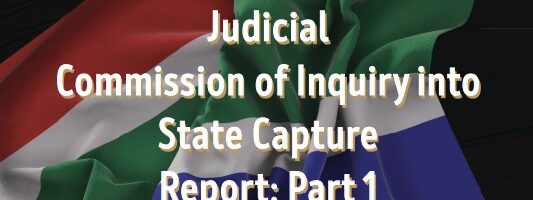Data visualisation can be a useful way of making sense of complex topics. Over the past few years, Thembani Phaweni and I have taken to visualising important state capture documents as networks that show the main entities, and clusters of entities involved. We’ve done it for Thuli Madonsela’s State of Capture report and for Jacques Pauw’s The President’s Keepers book. This can be a useful way of getting a bird’s eye view of an otherwise challenging document.
We use NLP (natural language processing) to construct these networks. We start by extracting the “parts of speech” and focus on the named entities (i.e. proper nouns). We then connect the named entities if they appear within a certain number of words of each other (i.e. they are being spoken about together). This gives us the below network. The result is a bit messy with some duplicates and unrelated nodes, but is still very readable as it highlights the main patterns.
You can access the full report here.
Overall network
The first thing to note is that the network looks very similar to the previous networks mentioned above. The Zondo Commission did not highlight much new that we did not already know as far back as 2017, although it added new details and put things on a firmer legal footing. Justice takes time.
Below is what the overall report looks like. Node size indicates how many other entities that entity was connected to (i.e. spoken about with). Given that the main thrust of the first report was capture at the SAA (South African Airways) and the GCIS (Government Communication and Information System), we see that these feature prominently.
Key movers such as the Gupta Brothers, Dudu Myeni and Former President Zuma also feature prominently, as does former SAA Technical (SAAT) board member, Yakhe Kwinana, who the commission described as “clueless or dishonest“.

Specific clusters/communities
Let’s now zoom in on some of the most prominent clusters of entities, starting with the SAA community. Other prominent entities included Dudu Myeni personal advisor, Masotsha Mngadi; whistleblower, Cynthia Stimpel; former SAA CFO Phumeza Nhantsi; Masimba Dahwa, who was allegedly fired from SAA for resisting corruption; and, former acting SAA CEO, Mathulwane Mpshe, amongst others.

Then we move on to the SAA Technical (SAAT) report where Kwinana stands out prominently as a key player. Also prominent were former SAAT procurement head, Nontsasa Memela, and businessman, Vuyisile Ndzeku, who is accused of paying himself R2.5 million, amongst others.

The third major area of the report was the capture of the GCIS (Government Communication and Information System) which deals with government messaging and similar by the Guptas brothers who used the GCIS’ budget to prop up the media empire, including The New Age (TNA) newspaper. As we now know, Former President Zuma played a direct role in setting up this alternative media empire, even going so far as to weigh in on names.

Finally, let’s look at two more communities of interest: that around Regiments Capital and around SA Express, although I am not going to provide much commentary on these…


There you go. With this context, it should make reading the actual report much easier 🙂





Hi there – nice work making this so palatable for someone like myself! Is there a way to view these images in a higher resolution perhaps?
Thanks for the kinds words. I did include a hi-res version of the overall map at the end of this tweet thread: https://twitter.com/superlinearza/status/1483442471640215552